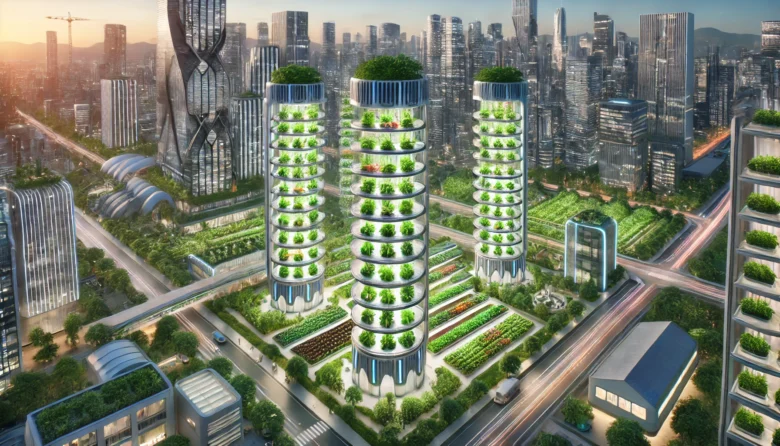In a world where cities are rapidly expanding, and climate change is altering the environment, “The Future of Urban Agriculture: Adapting to a Changing Climate” is becoming a crucial topic of discussion. As urban areas continue to grow, traditional agricultural practices are challenged by shrinking farmlands, changing weather patterns, and a surge in demand for fresh produce. How can we keep up with these challenges while also ensuring sustainable and climate-resilient food production in cities? Urban agriculture (UA) offers a beacon of hope, providing innovative solutions to these pressing issues.
Role of Urban Agriculture in a Changing Climate
Urban agriculture refers to the practice of cultivating, processing, and distributing food within urban areas. It’s not just about rooftop gardens or community plots; it also includes vertical farms, hydroponics (soilless farming), and even urban livestock. With the climate becoming more unpredictable—extreme weather events, heatwaves, droughts—urban agriculture can serve as a more localized and controlled way of growing food.
In cities like Bengaluru, where rapid urbanization is pushing agriculture to the outskirts, urban farms provide fresh, climate-resilient produce. The idea is simple: grow food closer to where people live, reducing transportation emissions, food spoilage, and overall waste.
Innovative Techniques Paving the Way
As urban agriculture adapts to climate change, technology plays a crucial role. Innovations such as vertical farming, hydroponics, and aquaponics are emerging as game changers.
Vertical Farming: By stacking layers of crops in controlled environments, vertical farming allows urban farmers to maximize space and grow food year-round. Companies like AeroFarms (a company specializing in vertical farming technology) use climate-controlled systems to grow leafy greens without soil, cutting water use by 95%.
Hydroponics and Aquaponics: Hydroponics (growing plants in nutrient-rich water) and aquaponics (combining fish farming with plant cultivation) are methods that help grow food in areas with limited space or poor soil quality. In India, startups like Urban Kisaan (which sells hydroponically grown produce) are pioneering the use of these systems in urban areas like Hyderabad.

Adapting to Climate Change: Localized and Resilient Food Systems
The main benefit of urban agriculture is that it localizes food production, making it less vulnerable to climate disruptions. Cities like Mumbai are experiencing unpredictable monsoons, and conventional farms struggle with the changing rainfall patterns. However, urban farms can adapt by controlling water use more efficiently through smart irrigation systems and rainwater harvesting.
For example, the Pasona Group (a company with an urban farm in Tokyo) has transformed its office spaces into farms, using low-energy LED lights and climate-controlled rooms to grow produce. This allows them to bypass extreme weather conditions entirely, ensuring food security even during storms or droughts.
Urban Farming as a Response to Food Security Concerns
As the world’s population is projected to approach 10 billion by 2050, the issue of food security is increasingly critical. Urban farming offers a way to produce food within city limits, reducing the reliance on rural agriculture, which is increasingly vulnerable to climate shifts.
In India, urban farms in Chennai and Delhi are focusing on producing high-nutrient crops like spinach and kale, which can grow in small spaces. This decentralized approach ensures that cities remain self-reliant even during food supply chain disruptions caused by extreme weather.
Sustainability Benefits of Urban Agriculture
Beyond food security, urban agriculture contributes to sustainability. By growing food locally, cities can reduce their carbon footprint. Traditional farming often involves long-distance transportation and excessive use of chemical fertilizers. Urban agriculture minimizes these emissions while also promoting eco-friendly practices.
Take the example of Gotham Greens (an urban farming company that sells hydroponically grown produce in the U.S.), which uses 100% renewable energy to power its farms. Gotham Greens, an urban farming company, conserves up to 90% more water through its greenhouse farming techniques compared to conventional agricultural practices.
In India, urban farmers in Pune have started incorporating solar panels into their rooftop gardens, not only growing food but also generating renewable energy. This integration of agriculture and renewable energy is a promising model for future cities.
Challenges to Overcome
While urban agriculture presents many opportunities, there are challenges. Space is limited in cities, and urban farms must compete with real estate demands. Additionally, starting a farm can be expensive due to the high cost of technology and infrastructure required for vertical farming or hydroponics.
Another challenge is public awareness. Many city dwellers are still unfamiliar with urban agriculture and its benefits. For urban farming to truly thrive, it will require both policy support and community engagement. Governments must incentivize green spaces and offer subsidies for urban farmers, while city residents must embrace local food systems as part of their daily lives.
Case Study: Urban Agriculture in Singapore
Singapore is often hailed as a leader in urban agriculture. The city-state has limited land, yet it produces around 10% of its own food thanks to innovative urban farming techniques. Companies like Sky Greens (a company specializing in vertical farming) are helping Singapore reduce its dependency on food imports by growing vegetables in vertical towers. These towers are powered by a hydraulic system that uses minimal energy, making them both space-efficient and sustainable.
India can take inspiration from Singapore’s model by encouraging more urban farms in cities like Mumbai, Delhi, and Bengaluru, which face similar challenges in terms of space and food security.
Conclusion
The future of urban agriculture lies in its ability to adapt to a changing climate. Through innovative farming techniques, resilient food systems, and a focus on sustainability, urban agriculture can provide a viable solution to food security and climate challenges. Cities around the world are beginning to realize the importance of growing food locally, and with the right support, urban farming could revolutionize how we think about food production.
Call to Action: As citizens, we can support urban agriculture by buying locally grown produce, supporting policies that promote green spaces, and even trying our hand at small-scale urban farming. The future of our cities—and our planet—depends on it.
Author’s Note:
I believe that urban agriculture offers a sustainable path forward, especially as our climate continues to change. By embracing innovation and thinking creatively about space, we can transform cities into green, food-producing hubs that benefit both people and the planet.
G.C., Ecosociosphere contributor.
References and Further Reading:
- Discover the 5 different stages of hydroponic gardening.. https://www.greengrins.com/post/discover-the-5-different-stages-of-hydroponic-gardening
- Green Urban Planning: Promoting Sustainable Development – If Not Wind. https://www.ifnotwind.org/green-urban-planning-promoting-sustainable-development/




